Chinon: castle of one of the wonders of the Orleans virgin
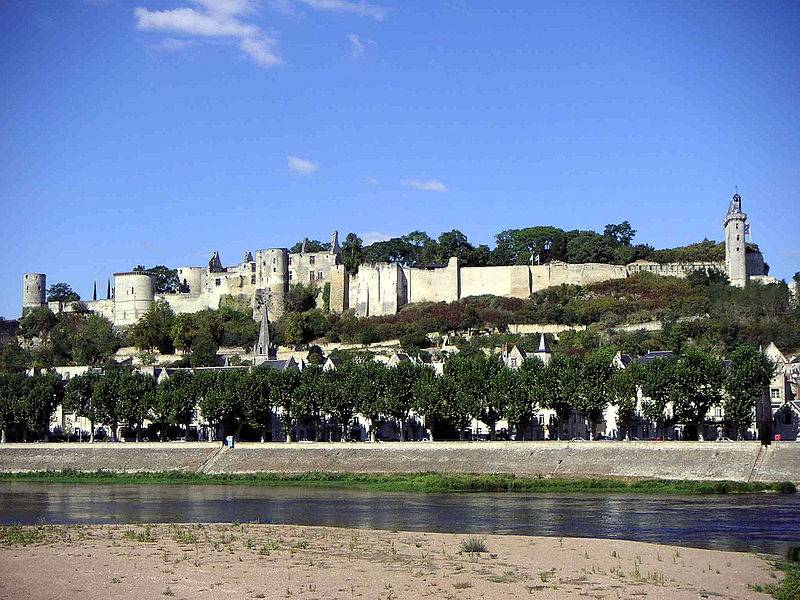
Chinon Castle
“Anjou”, “Chinon”, “Bourgeois”, “Vouvray”, “Sancerre” ...
The king drank them, not like the dauphin ...
Pavel Mityushev, Mir, vol. 3
Castles and fortresses. Every summer, more and more Russians travel abroad to rest. It is possible that among them there will be those who will be in France either in the castle of Chinon itself on the banks of the Vienne River, or near it. In any case, you should go there and examine it, because in fact you will find yourself not just in the castle, as many as thousands in France, but in the place where it was directly created story! Yes, that's right, and the story, which is rooted in the darkness of centuries ... On the pages of "IN" we already told about the secret graffiti of this castleallegedly pointing to the hidden treasures of the Templars. But when and how was this castle built and how did it become famous, besides the fact that disgraced Templars were kept in it? Our story about it today ...
Even at the site of the castle of St. George - the foremost fortification of Chinon, the ancient dwelling of the Gallic leader was found, which means that people settled in this place a very long time ago. The remains of the walls of the Roman settlement of the 954th century AD were also discovered there. It is known for sure that the first stone tower in its place was built on a mountain spur in 90 by the Blois Earl Thibault the Scammer. But 1044 years later, in 1068, he was captured by Joffrey Martel, Duke of Anjou, who turned him and all the lands around into his own domain. Well, his nephew Fulk IV, nicknamed Grumpy, went even further. In 1095, he usurped the title of Count Anjou, which was supposed to belong to his brother, and imprisoned him in his walls for almost thirty years. It got to the point that in XNUMX, Pope Urban II, who visited Tours, in order to preach the Crusade, had to personally come to Chinon in order to achieve his release. But the same Fulk also introduced a special tax on his vassals and began to strengthen the castle with these funds.
In 1109, after the death of Fulk IV, his grandson Joffrey V of Anjou, nicknamed Handsome, adopted another nickname Plantagenet - “The Gorse Flower”, which was depicted on his coat of arms, and became the foundation of the Plantagenet dynasty, since his son Henry II later became king of England.
In 1152, Henry Plantagenet married Eleanor of Aquitaine, just divorced from the king of France. She brought him Aquitaine as a dowry, and in thirteen years she bore him eight children, five of whom were boys.
Having become king of England in 1154, Henry built numerous palace buildings in Chinon, where his administration was located and even the “Treasure Tower”, where his treasury was stored. And it turns out that for many years spent by the king in moving from England to France and vice versa, it was Chinon who was his capital and the main military base of all his military operations on the continent! And in 1173 this castle also became a prison for his wife Eleanor. Accused of supporting several conspiracies of her sons against her father, she was kept here for almost fifteen years, first here, and then under house arrest in England. When Henry II died in Chinon in 1189, his children inherited a rich and powerful state, but their rivalry weakened him to the limit.
Local legend claims that Henry's son, King Richard the Lionheart, after the ill-fated wound with an arrow in 1199, also lost his spirit in Chinon, although most likely he was already dead when his body was delivered to this castle.
Then the plantagenet crown was inherited by Richard's brother John, who received the nickname Landless. Again, it was in Chinon in August 1200 that he celebrated his wedding with Isabella of Angouleme, cousin of the king of France, and then fortified Chinon against the French king Philip Augustus for another two years. However, despite all his efforts, the fortress still fell in 1205 under the blows of the army of Philip, after which John in 1214 had to sign a truce here with Philippe, depriving him of many possessions in France.
Well, then the castle turned into a royal prison and was most closely associated with the history of the Templars and their mysteriously lost treasures.
Well, then, already during the Hundred Years War, the future Dauphin Karl, in the future the King of France, Charles VII, having married Marie of Anjou, it was Chinon who made his summer residence, where since 1427 his entire courtyard has been located.
And then a truly historic event took place here that radically changed the fate of France: in March 1429, Jeanne d'Arc arrived in Chinon, where they meet with the Dauphin, convinces him to be crowned in Reims, and give her an army to free Orleans besieged by the British. This famous episode of an epic story is usually portrayed as a kind of mythical and absolutely wonderful scene. According to legend, Karl’s courtiers decided to test the girl by dressing up the dauphin in simple clothes and hiding him in the crowd, but Jeanne unmistakably recognized him among other people. However, in fact, in Chinon there were two meetings of the Dauphin and Jeanne. The first took place in February of this year in the apartment of the Dauphin, after which he sent her to Poitiers to meet with the theologians in order to check. Upon her return, she was again received by Carl. This second audience was already more official in nature, and then, as often happens, both of these meetings merged into one, and then a decent share of mysticism intervened in this story. It is believed that when Jeanne recognized the dressed king hidden among the courtiers, she told him something that proved her omniscience and instilled vigor and confidence in him. Later, during interrogation, Jeanne told another story in which she claimed that the king received a sign that helped him recognize her. It was a "beautiful, honorable and good sign." Later, she already said that an angel appeared then, who “stepped to the ground”, “entered the hall through the door” and gave the golden crown to Archbishop Reims, who, in turn, handed it to Karl. In any case, the symbolism of the situation is completely obvious. But the “miracle” did not pass in vain, but helped Karl regain his kingdom. It’s just that no historical sources confirm exactly this nature of their meeting, and how everything was really unknown to anyone. And this is just one secret from the many secrets of Chinon Castle, which, apparently, we will never be able to solve!
The last fortification works in the castle were carried out in 1560 during the so-called “Wars of Faith”, after which the castle was abandoned and began to decline into a little.
In 1632, the almighty Cardinal Richelieu became the owner of the castle, and in accordance with local legend used his stone to build his own castle. However, most likely Richelieu simply demolished the Throne Hall and the tops of the defensive towers. By the beginning of the 1854th century, Chinon Castle was a ring of dilapidated walls and ruined towers - although it was one of the most impressive structures of this type not only in France but also in Europe. In XNUMX, there was a danger of the castle collapsing, and then the general inspector of historical monuments, the famous French writer Prosper Merimee, spoke in favor of his rescue. Work was begun on its restoration. In the royal chambers, the floor was restored according to the original drawings, and the rooms themselves were furnished with copies of antique furniture. To date, a number of buildings have already been restored in the castle in the form they had in the XNUMXth century, and overlayings made of local aged oak and tiled roofs from Anzhevinsky slate were installed over them.
Well, now that we have got acquainted with all the main secrets of this truly unique castle, let's look at it both from the outside and from the inside. From above, this castle has the appearance of an elongated rectangle consisting of three castles - St. George, the Middle Castle and Kudrey Castle. You can get into it through the entrance on the eastern side, where even Henry II Plantagenet built several buildings for his administration and yard. They were named after the chapel of St. George, the patron saint of the knights, which was located here, and at first these buildings did not have any defensive significance. However, forty years later, the son of Henry II, King John the Landless, surrounded them with a wall and turned it into an advanced fortification on the side of the road to Tours. These buildings today have not been preserved, only the walls, and here, near the bridge to the Middle Castle, there is a tourist center.
This stone bridge, with several arches, is thrown over a dry moat and leads directly to the gates of the high Clock Tower dating to the end of the 1370th century. Inside the tower there are five floors connected by a spiral staircase. Next to the clock is a beating bell named Mary Javel. Passing through the gate in the tower, we find ourselves on the territory of the Middle Castle, where the first thing we see is the remains of the royal apartment near the southern wall of the castle. They were built and rebuilt for many years. Around XNUMX, the Duke of Anjou Louis I undertook their reconstruction, attaching to them the "Hall of Justice". Under Charles VII, there were already three large buildings located around the entire courtyard. In the royal chambers of the second floor there was an entrance hall, a bedroom, a bathroom and a dressing room. On the first floor there were office premises and a refectory. Located in the eastern part of this wing, the Hall of Justice since the XNUMXth century has become the Great Hall, also known as the Hall of Recognition. On the north side, one of the buildings of the Saint-Mele monastery was rebuilt into a ballroom.
Climbing the wall, we can go to the Boissy tower, which was erected in the XNUMXth century, possibly during the time of Louis IX, on the south side of the castle. It got its name from the Boissy family, who owned the Chinon castle in the XNUMXth century. On its first floor there is a security room, in the walls of which there are narrow loopholes for archers, through which you can watch the valley and the moat of the castle of Kudrey. A staircase built into the wall leads to the upper two floors and to the terrace. From it, the path goes to the Kudrey tower, but in the old days it was not easy to get into it: the entrance to it was preceded by a drawbridge.
Kudrey Tower is one of the three surviving towers built by Philip Augustus after he captured Chinon in 1205. Its name may be due to the presence of a grove of hazelnuts inside the fortress (“coudres” in the old French language), since the tower itself is located inside the castle and together with the drawbridge and walls forms the castle of Kudrey - another “castle in the castle”. Inside it are three intact floors. The first two are blocked by Gothic vaults, and the passage itself is located on the second floor. The tower has fireplaces and latrines. The lower room has an entrance to the tunnel, allowing escape from the castle in case of siege. The same tower was used as a prison for the Knights of the Order of the Temple in 1308.
King John’s Mill Tower is a key element of Kudrey Castle, located on the wall immediately behind the Boissy Tower. The first floor with a polygonal layout and a segmented domed roof is typical of its time, but is very rare in plantagenetic castles. The tower owes its name to the presence of a windmill, which supplied the castle with flour of its own grinding. And this is the only castle tower protecting its wall on the west side. The first floor of the tower is not connected with the second floor, which is accessible only through the passage along the wall. Both floors have loopholes, with embrasures in the niches of the walls, which again was characteristic of that time. The staircase goes up in the thickness of the wall.
In 1477, King Louis XI entrusted the Chinon fortress to his biographer Philippe Commine, the owner of the castle of Argenton-le-Valle. He strengthened the northwestern corner of the Middle Castle, building a new, more robust tower that could withstand artillery fire, which in honor of the new owner's estate was called Argenton. Its walls are five meters thick, and the loopholes for the guns are very low, at the height of the moat. In the XVII century, this tower served as a prison, as evidenced by graffiti on its walls.
The Canine Tower was also built by Philip Augustus, but differs from all others in that it has the shape of a horseshoe. It owes its name to the nearby kennels that housed the royal hounds. It has three vaulted floors topped by a high terrace. The entrance to it is located on the middle floor, and here you can see a large oven for baking bread, and latrines are located between the first and second floors.
The castle, if you go around it, seems huge, although due to the lack of many buildings and quite empty. However, in the past it was a real small town, where at the same time there were people, and dogs, and horses, in fact, a small state in the state, surrounded by strong fortress walls!
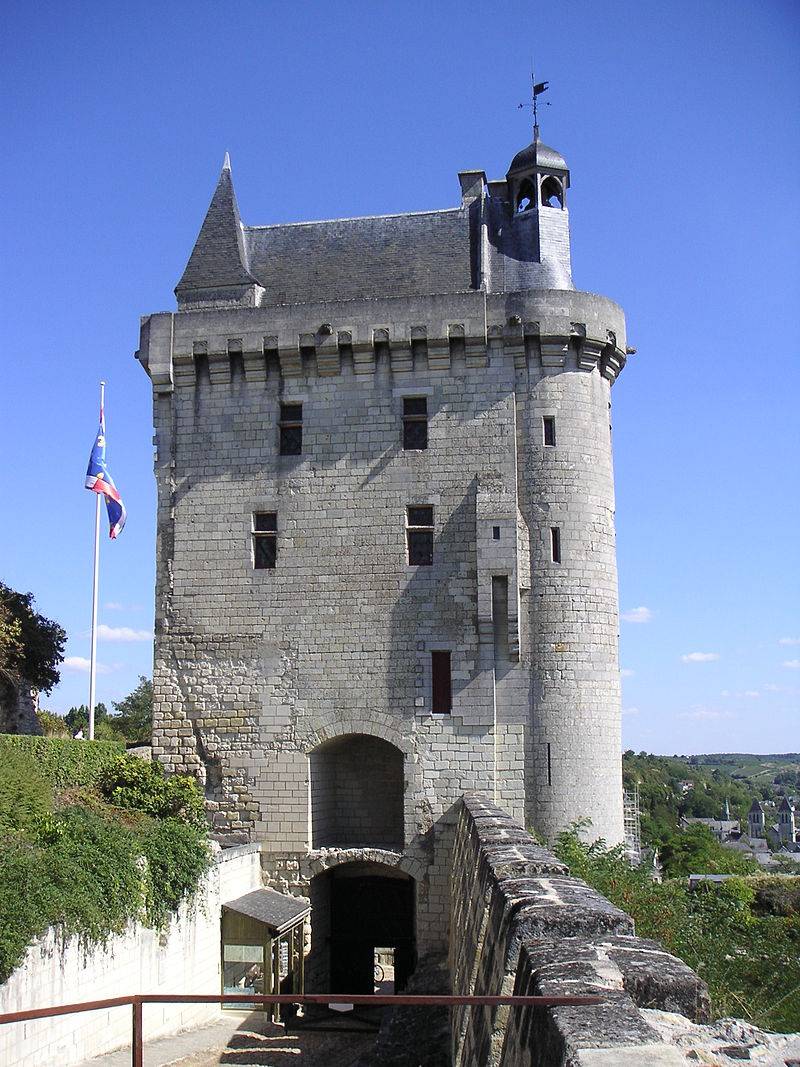
1. Clock Tower of Chinon Castle - view from the inside of the castle. The little turret protruding from the wall at the second floor level is the toilet!
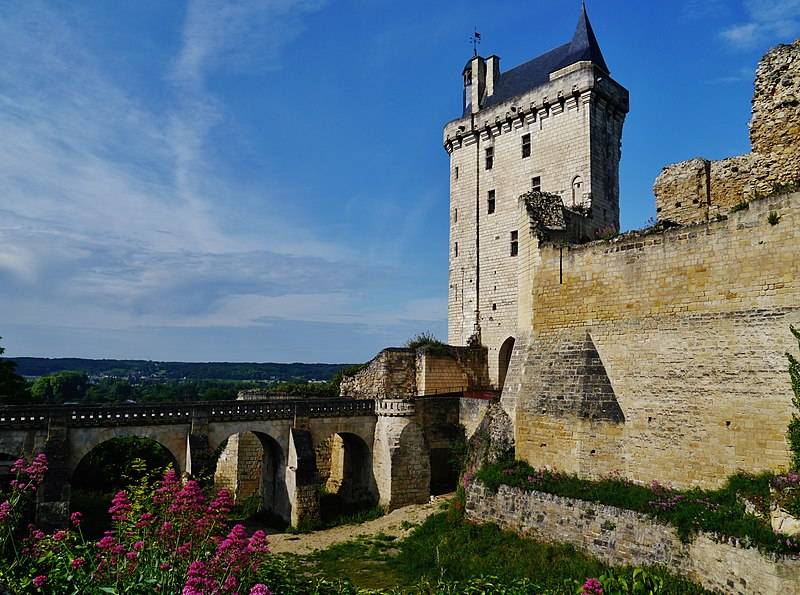
2. Bridge to the Clock Tower through a dry moat
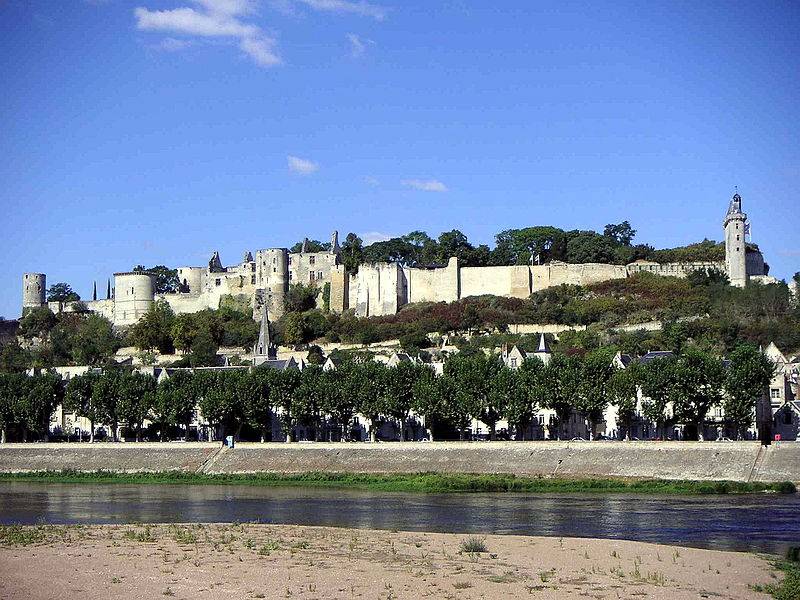
3. Chinon Castle in the city of Chinon, on the banks of the river Vienne - one of the royal castles of the Loire. Castle buildings from left to right: Mill Tower, Boissy Tower, ruins of the royal apartments, treasure tower and Clock Tower
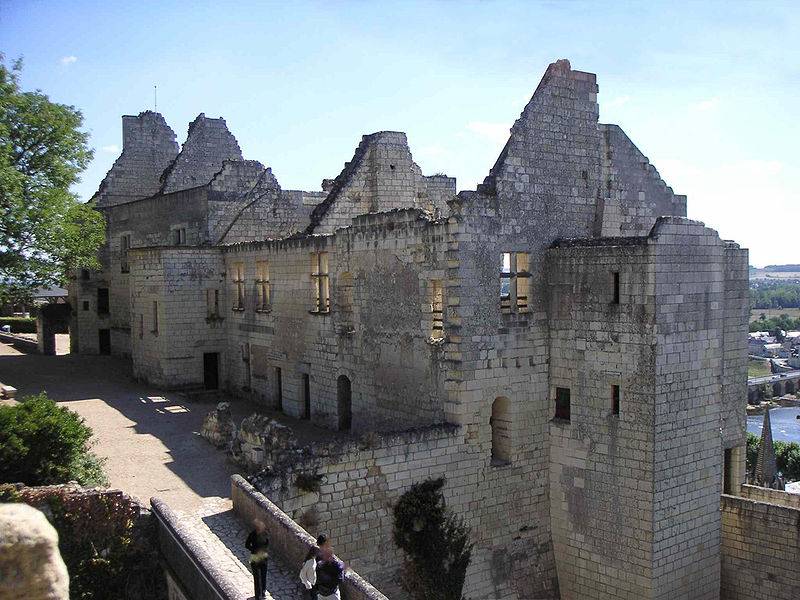
4. View of the royal chambers of Chinon Castle
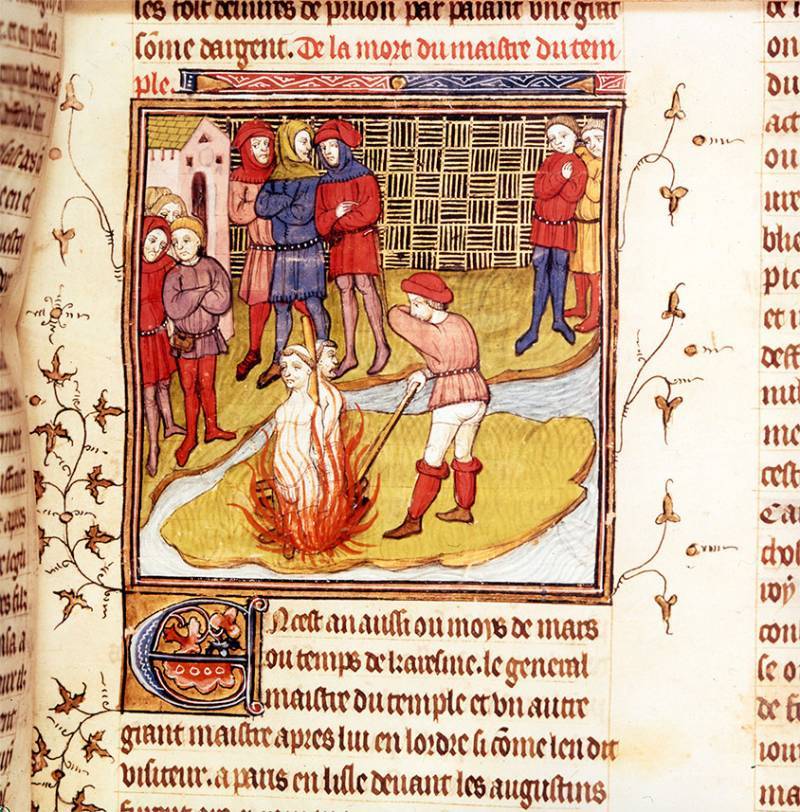
5. The execution of the Templars - the Grand Master Jacques de Molay and Geoffrey de Charnet. Thumbnail from the manuscript of the Chronicles of Saint-Denis. British Library, London (public domain picture)
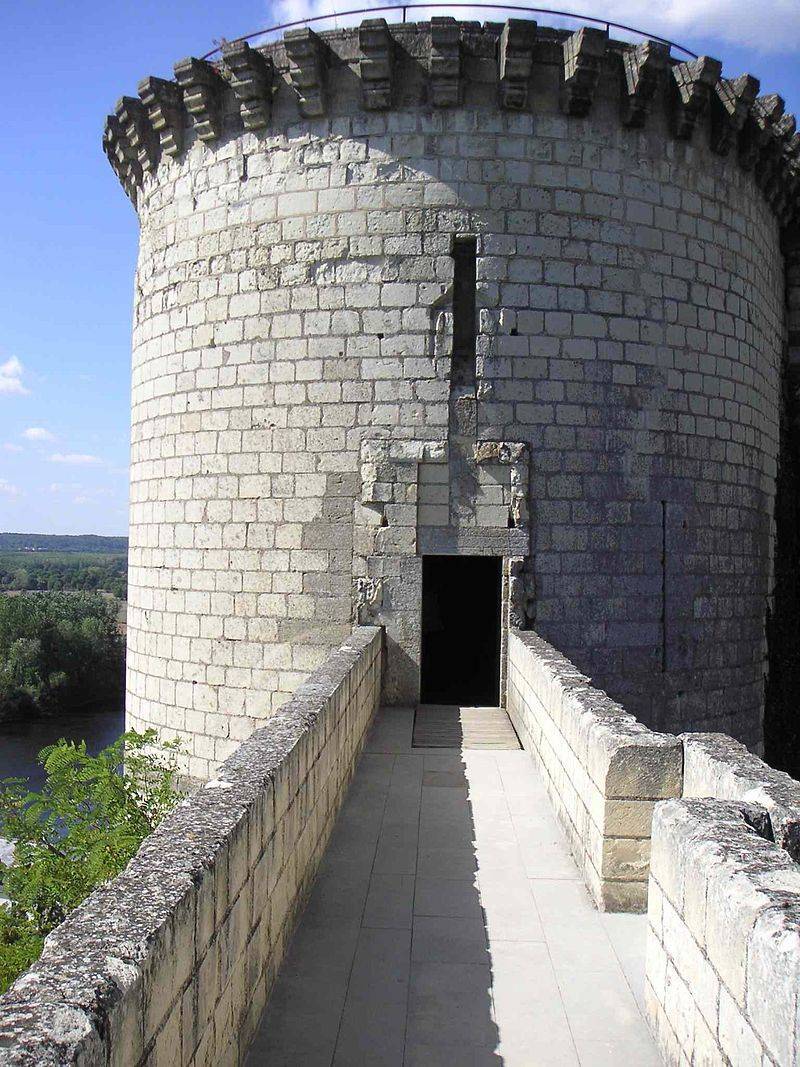
6. Boissy Tower
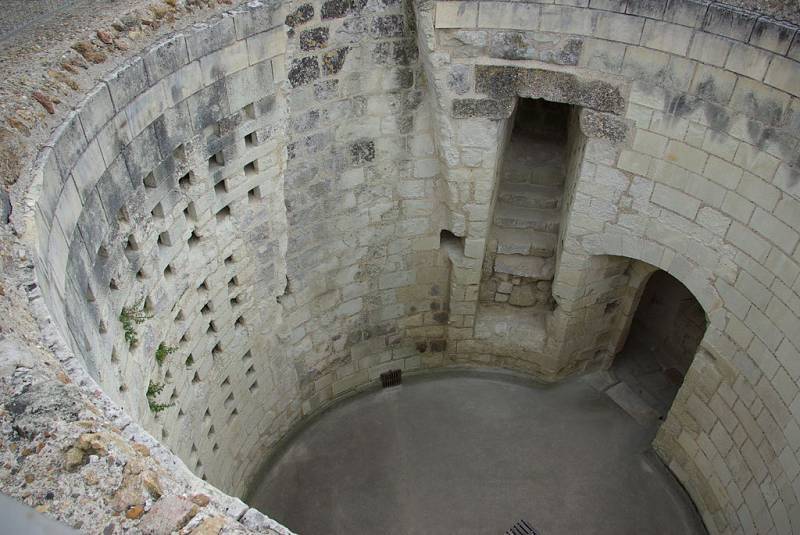
8. Here in the premises of the Templars and kept ...
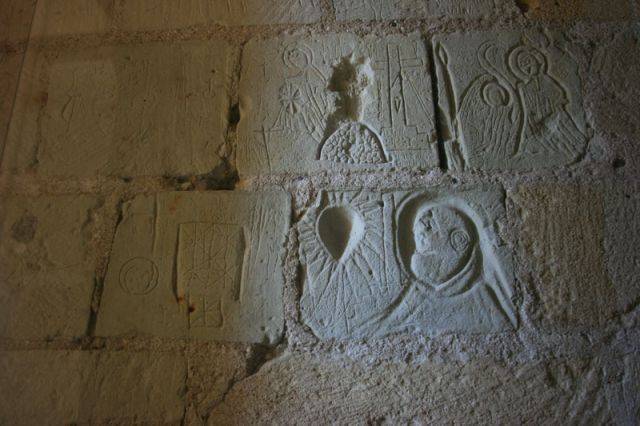
9. Mysterious Templar Graffiti
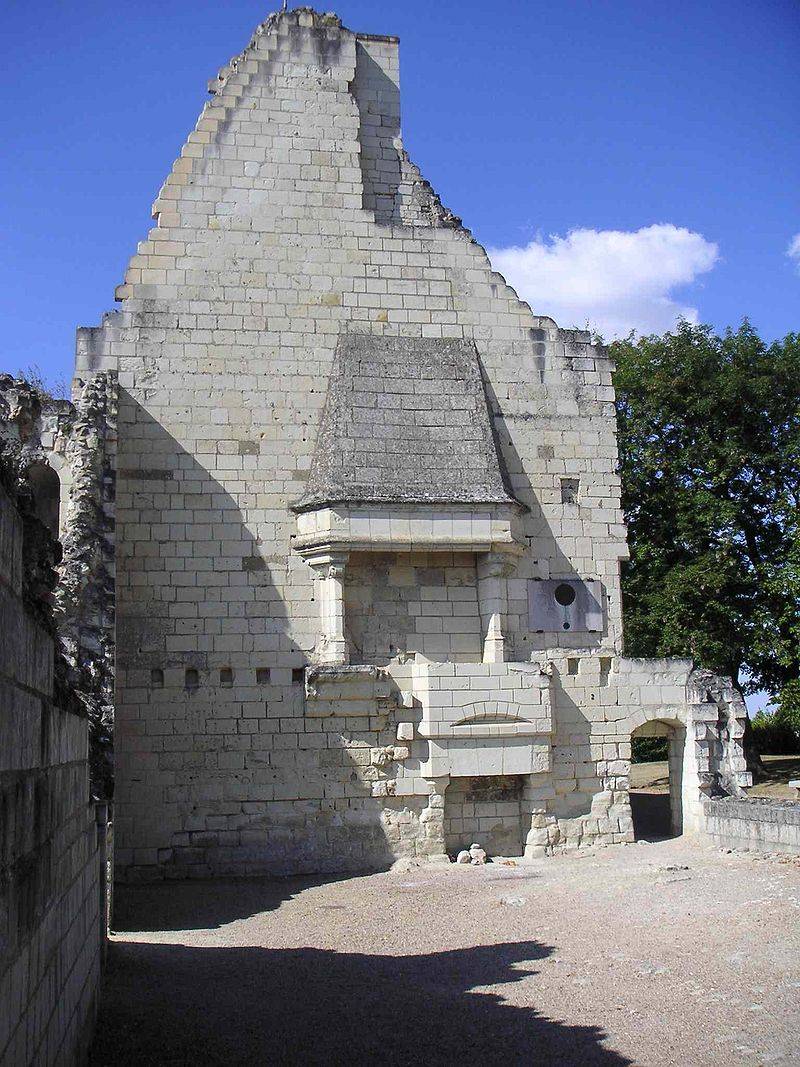
10. All that remains of the great hall of the royal chambers of Chinon Castle
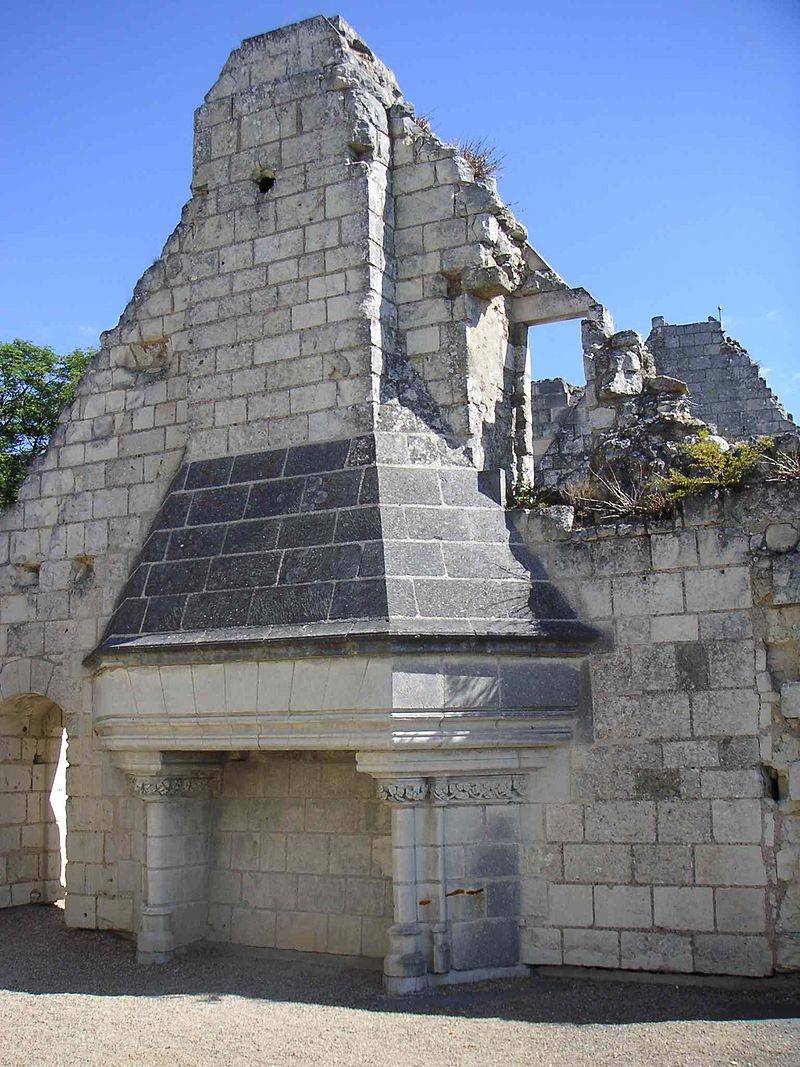
11. Fireplace of the royal chambers of the second floor
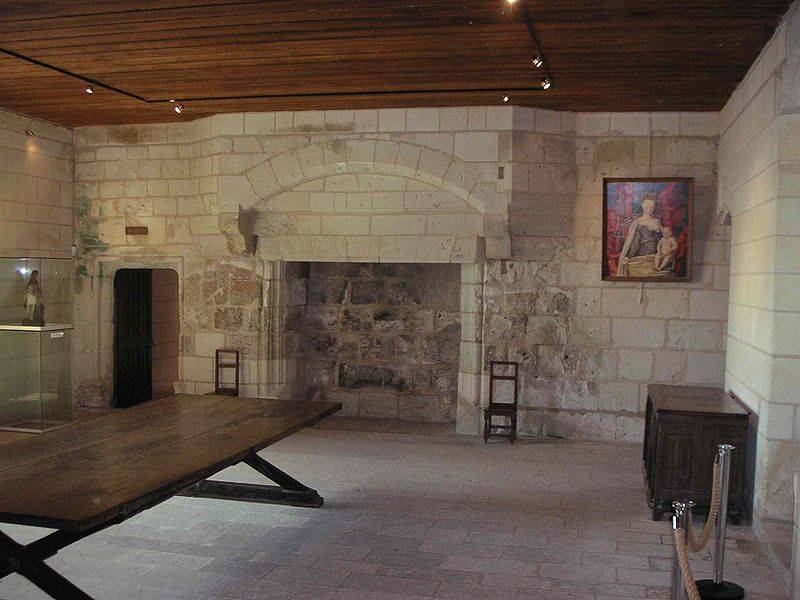
12. Inside one of the restored rooms of the royal chambers
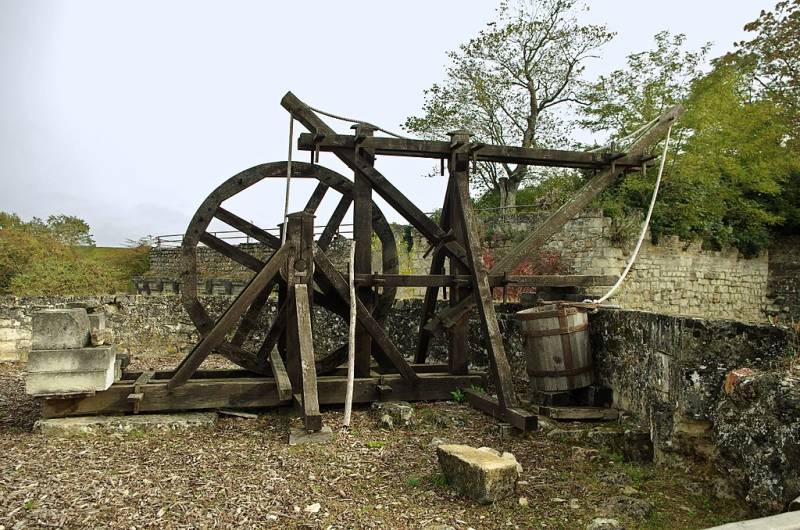
13. In the castle you can see the reconstruction of a wooden medieval construction crane. It is a stationary winch with a stepped wheel. Such a crane, despite a primitive device, could lift a load weighing up to 500 kg. Such "machines" were very widely used on construction sites at the end of the XNUMXth century.
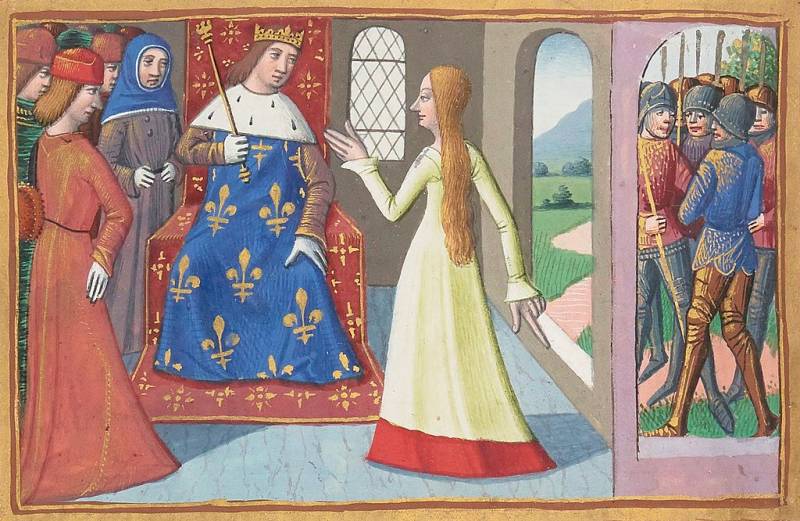
14. Joan of Arc in front of Dauphin Carl in Chinon. Thumbnail from The Vigil on the Death of King Charles VII. Around 1484, National Library of France, Paris
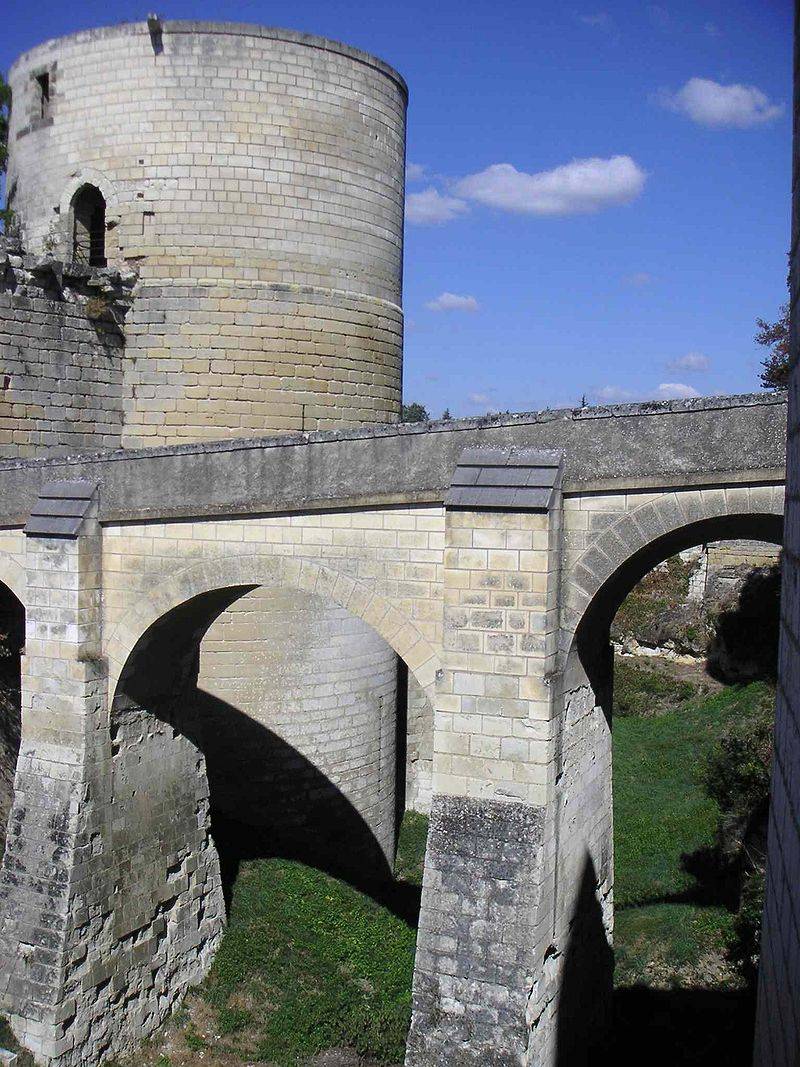
15. Stone Bridge Leading to the Boissy Tower
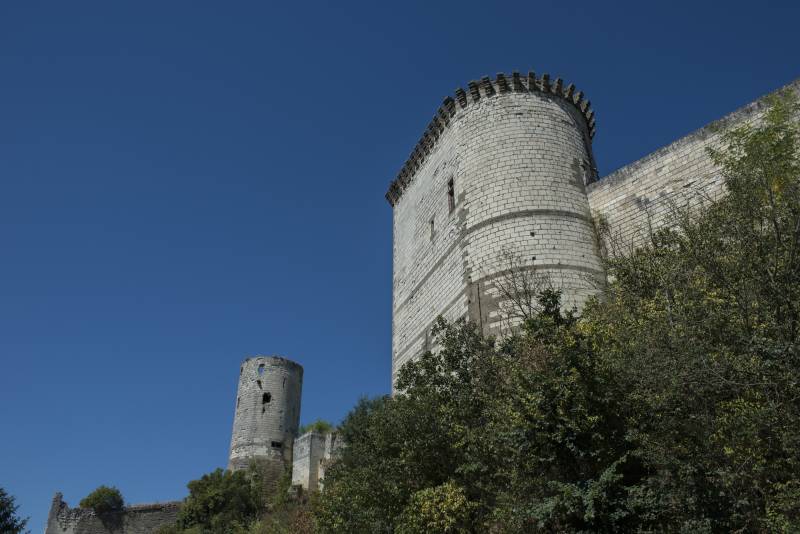
Information